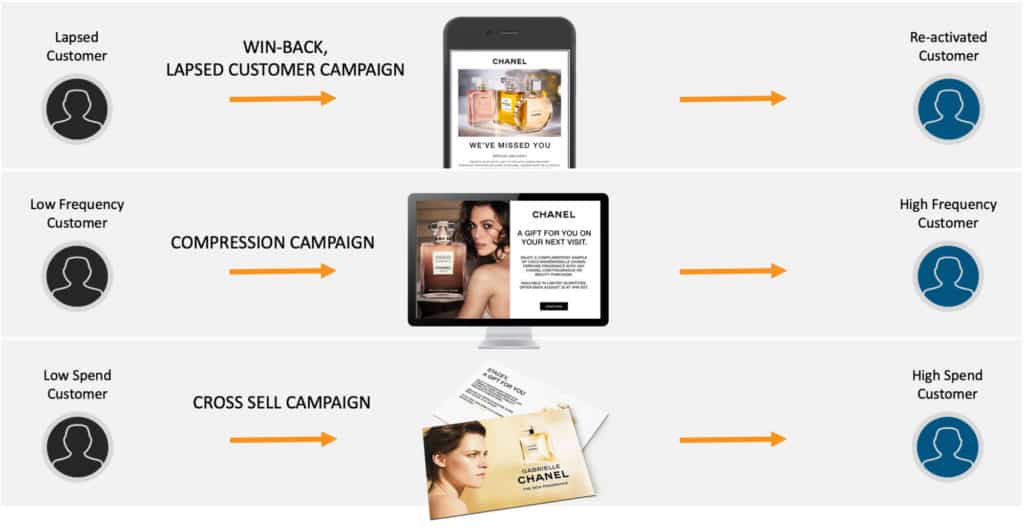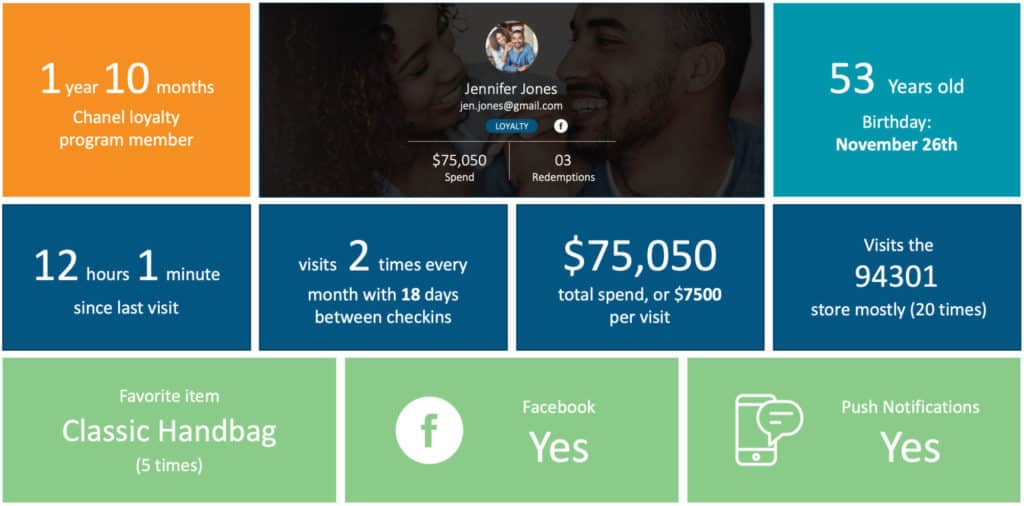Redefining Customer Loyalty Programs
Marketers are challenged today to define their customer loyalty program beyond its ability to deliver transactions. Loyalty is evolving into much more than simply a static program that creates member habits, which often aren’t even optimal to maximizing brand affinity.
Customer loyalty program initiatives in 2021 must focus on long-term value to deliver dynamic loyalty inclusive of every kind of customer and their range of expectations. Loyalty solutions must be inclusive of current customer trends, such as financial incentives, personalized experiences, ways to support their favorite causes, and advocacy opportunities to tell friends about the brand. Here’s an important checklist when beginning your initial loyalty program RFP process:
Top Customer Loyalty Vendor Platform Capabilities Checklist
- Offers Omnichannel Communication – including email, SMS, and Push notifications
- Manages Customer Data – Captures, stores and provides visibility into all internal and external data to deliver a 360 degree view of the customer
- Automates Marketing – Launches built-in, targeted campaigns for events, sign-ups, winbacks, geotargeting, and more, along with the flexibility to manage them on the fly to accelerate outcomes
- Provides Analytics – Delivers insights and predictions of customer behavior that can drive personalized campaigns and offers
- Administers Programs Across the Customer Journey – Provides customer acquisition and loyalty management through user-friendly access for all business locations
- Delivers High Performance – Achieves seamless customer experiences through enterprise-grade scalability, availability, and security.
A customer loyalty program is the key to holistic engagement that builds a brand along every customer touchpoint and channel and across every instore and online experience. Embracing loyalty in this manner acknowledges the highly important exchange of values between the customer: who receives personalized offers and experiences, and the brand: who in return gets detailed knowledge of their customers, allowing for better data-driven segmentation and targeting to create the 1:1 connections that will sustain and grow their brand into the future.
This is no easy task as new technologies, multiple systems, changing vendors and ever-increasing customer expectations, make system integrations and program participation an ongoing challenge. However, working with a loyalty vendor that provides a single platform with quick APIs so accurate, quality data can be gathered, maintained and layered to leverage loyalty initiatives is imperative today.
From the platform and without the help of IT, marketers can nurture customers and deliver personalized messages and experiences that make them feel more important than being targeted via a mass campaign that doesn’t speak to their specific wants or desires or pain points. A vendor loyalty platform helps marketers build value into their brand through personalization that enhances customers’ perceptions and increases their engagement.
Customer Loyalty Program Advantages
Restaurants, retail, grocery and convenience stores are utilizing loyalty programs more often than ever before. These industries understand the importance of retaining existing customers and choose to implement a system directed specifically at building customer loyalty. Some marketers may think of loyalty programs and initially imagine a large portion of existing resources being funneled away into a program that doesn’t deliver ROI.
However, in reality, pursuing new customers is the true cost burden; a February 2018 article in Forbes asserts that keeping an existing customer is 5 times less expensive than acquiring a new one and increasing customer retention by 5% can increase profits from 25%-95%.
Customizable loyalty programs provide brands the ability to incentivize customers to return and to participate in other ways such as to advocate to friends or to support their favorite causes, further enhancing the overall value of the company. As customer interactions continue expanding beyond just visits, loyalty now occurs across a range of channels and touchpoints such as sentiment surveys, gamification, social feedback, referrals, etc.
The spring of 2020 also highlighted the importance for organizations to identify their customers and have the means to communicate with them digitally. The pandemic created new circumstances and changes to daily operations for many businesses. Brands needed the ability to message customers on a digital channel and in an appropriate tone about new procedures, updated business hours, temporary closures, and relevant or redesigned offers, as face-to-face visits were not an option.
The best loyalty programs have responded to these new market conditions and enable companies to develop customer relationships through omnichannel communications and relevant incentives designed to create and optimize a variety of interactions.
Customer Loyalty Program Checklist
Meeting changing customers’ expectations for convenience, value and personalization typically requires integrating a software platform dedicated to engaging and rewarding customers. This guide details the critical components necessary for a comprehensive loyalty solution and highlights the ROI brands can achieve with these programs.
Customize Customer Loyalty Program Structures to Your Brand
There are multiple ways to keep customers happy. Organizations should consider the types of program structures a vendor can support. Brands need to determine the best structure for their program and also the flexibility of the vendor to customize components. Here are several key loyalty structures:
- Spend- & Visit- Based: Incent customers with points for every visit, reward them for completing a defined number of visits, or offer bonus points for certain interactions or events
- Spend Unlocks Redeemables: Convert customer visits into points and set-up offers with customizable rewards and membership levels, for progressive redemption
- Tiered Membership: Encourage customers to earn more attractive rewards and achieve higher membership levels with each visit
- Surprise & Delight: Delight customers with unexpected rewards for every visit they make through offers and gamification
- Stacked Rewards: Customers earn loyalty points from in-person visits and online actions. These points can be stacked and used for various redemption opportunities.

Create Digital Marketing Campaigns & Personalized Loyalty Offers
Organizations often have lean marketing teams that have multiple responsibilities. They need the ability to easily develop and manage campaigns from a single platform to provide a regular cadence of messages that remind customers of their program and provide offers to participate. Campaign delivery should be available through email, Push and SMS. Loyalty platform campaign capabilities should include:
- The import and management of marketing lists via file uploads, 3rd party integrations, and online forms
- Real-time updated customer profiles to create segments with multiple customer attributes
- An extensive library of built-in marketing campaigns—event-based, sign-up, gift-bearing, referral, winback, and more— that can be run manually or scheduled to run automatically
- Ability to run local store marketing campaigns from the corporate office or grant local-store level permissions to run offers for specific locations
- Ability to define integrated, omnichannel offers based on specific rules and which are redeemable and trackable to the specific customer and in real-time
Gather Data with Seamless Third-party Loyalty Program Software Integrations
Loyalty programs need to seamlessly integrate with an organization’s existing tools and technologies. Look for a platform that provides an extensive set of APIs for quick integrations to various systems, such as enrollment systems, payment systems, guest Wifi, gift cards, and other marketing activities.
Customer case studies can help brands understand how a loyalty vendor delivers on key integrations and works with a business’ multiple systems to deliver a cohesive approach to creating lasting customer relationships.
Drive Big Data Unification & Accessibility to Track Trends
Most customer loyalty programs come with a useful method of data accumulation. Some vendors offer data reports, which vary from providing raw data to offering more in-depth analysis. Look for a platform that unifies data from multiple systems and utilizes a dashboard to display daily metrics. This will offer organizations the best method for tracking trends and delivering real-time actionable insights. Performance data will yield results at the store, program, campaign, offer and customer levels to provide brands with a comprehensive view of their loyalty strategy. The data capabilities of a loyalty vendor provide some of the most valuable benefits to an organization now and in the future.
Use Gamification to Boost Your Loyalty Program Engagement
Through the use of contests, badges, sweepstakes, challenges and games customers are motivated to participate and earn rewards. Gamification offers brands a way to:
- Encourage recurring behavior – Associate a challenge with a benefit and as customers progress reward them as they develop new habits
- Incentivize specific actions – develop multiple actions customers must complete that fit business goals
- Provide engagement beyond transactions – give customers an incentive to engage on social platforms by taking a gamified quiz or submitting their own content
- Enable social proof and recognition – give customers badges when they accomplish a milestone and/or enable them to share their progress with their social network

Leverage the Power of Referrals & Social Sharing to Improve Customer Loyalty
Customer loyalty programs help create additional marketing efficiencies by driving a range of desired customer behaviors. Look for loyalty platforms that engage customers and make it easy for them to earn points for taking action to:
-
- Refer friends to join the loyalty program via their social media networks using their mobile app or their website
- Login and provide experience ratings, and submit feedback the organization can proactively address
- Share their ratings and reviews by posting them to their social media accounts

Boost Customer Loyalty with Next-level 2020 Personalization Tactics
Over 90% of marketing professionals see personalization as a “crucial” element of the customer experience, yet 51% say that their organization cannot deliver the personalization its customers crave. (Verndale) In order to create a truly personalized consumer experience, loyalty program campaigns should be personalized based on a brands’ data and enhanced by third-party data. This provides a complete profile of every customer’s demographic, psychographic, and in-store and online behavior attributes. Based on these characteristics, customer segments of all different types can be designed and targeted with specific campaigns to drive desired behaviors.
Loyalty is about identifying core consumers, appealing to their specific needs and preferences and building a level of trust with them. Organizations need to deliver this type of personalized 1:1 marketing.
Accurately Measure and Attribute Customer Loyalty through Performance Metrics
Customer loyalty programs should increase customer happiness and retention. There are ways to measure these things. Having a single dashboard for a holistic overview of loyalty program performance makes monitoring easy. Different programs call for unique analytics, but here are a few of the most common metrics organizations watch when rolling out loyalty programs:
- Visits, sign-ups, and referrals
- Real-time and historical campaign KPIs including email open rates, push notification open rates, reward redemption rates, and customer behavior analysis
- Customer retention rates
- Customer lifetime value (a composite metric of average frequency and spend)
- Same-store sales
- SKU-based loyalty (loyalty to specific products e.g. beverages, dress shoes, business class travel, etc)
Remember it’s important to keep testing and learning. Loyalty vendors can help organizations run an A/B test against program members and non-program customers to determine the overall effectiveness of a brand’s loyalty initiatives.
Work from a Single Platform Solution to Drive Efficiencies
Working from a single, scalable platform allows marketers to execute their loyalty strategy with ease. It’s important to have a hub that unifies data from multiple sources and makes it actionable to drive and optimize customer loyalty interactions. This increases participation and ROI.
With the right integrations and tools, marketers have the power to create personalized offers. Execution happens through automated campaigns that are delivered in real-time over customers’ preferred channels. This type of personalization connects brands with their customers in the most important ways.
Interested in learning more about customer loyalty programs? Contact Punchh for details related to your industry.
Stay in the know. Subscribe to our bi-monthly newsletter to receive proven loyalty strategies, offer management techniques, and new trends in your industry. Sign up today!